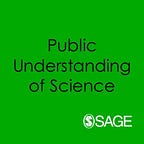50 Essentials on Science Communication
Review by Arko Olesk
The book is ambitious in its goal to cover a wide range of topics — the “essentials” of science communication, itself a diverse field.
For anyone wanting to learn about science communication, a simple Google search will turn up dozens of helpful resources. Specialised platforms such as RRI Tools or the European Citizen Science platform will help you select among hundreds of relevant tools and handbooks, and give a sense of the abundance and diversity of materials available for supporting science communication.
50 Essentials on Science Communication is not lacking the ambition that is needed to stand out in this dense and lively jungle of resources. This handbook is intentionally designed for an international audience: written in English, featuring an international set of authors, and avoiding national examples. It is freely available online and declares to be aimed at “researchers across all disciplines seeking further qualifications, entry-level employees in science communication departments and anyone who wants to take their first steps in the field”.
The book is ambitious in its goal to cover a wide range of topics — the “essentials” of science communication, itself a diverse field. The book has 50 (actually, 51, with AI a late addition) essentials, divided into five sections: Basics provides an overview of the guiding principles and main discussions in science communication, Strategy offers advice on target groups and organisational set-up, Get Started provides tips for designing the content of communication, Channels analyses the various formats that are available and Hot Topics prepares the reader for critical situations or controversies and makes them consider the ethical dimension of their work.
Finally, the ambition is also in the format. Each essential is given two pages exactly. The challenge for authors has been to show that they are capable of doing what is commonly expected from good science communicators: be brief but give enough context and nuance.
To evaluate how successful the book is in fulfilling these ambitions, two frameworks whose co-creation I have led are useful: the QUEST indicators for quality science communication and COALESCE standards, principles and criteria for science communication resources. The book promotes many of the principles outlined in these frameworks, but we can also use these to investigate how the book performs in practice.
Analysing the book as a piece of science communication, we see several indicators where the book excels. It is clear, concise and coherent: the chapters generally succeed in being engaging and succinct. Despite the large number of contributors, the editors have managed to keep a similar style and approach across the chapters. Many chapters build their advice on relatable situations or examples.
The book is well designed, visually attractive and has informative graphics. It is scientific, consistently referring to academic studies. And it does a good job in promoting the principles of responsible science communication, offering a nuanced view on the practice of science communication and is refreshingly reflexive, especially in the first and last sections of the book.
With this format, it is inevitable that authors and editors have had to make compromises. There is the occasional feeling of not getting the complete story or wishing for practical advice or a discussion that is more specific to science communication when the chapters restrict themselves to explaining general principles. This is, however, mostly alleviated by additional reading links at the end of each chapter.
When recently co-creating the resource evaluation framework for the library of the upcoming EU Competence Centre for Science Communication, a key point made by many participating stakeholders was that quality is determined by context. There can be no universal yardstick, they argued; rather, value is derived from knowing the target group and matching the needs of the users. As a result, we defined “contextual and purposeful” as one of the standards, encouraging creators to clearly specify the contexts in which their resources are to be used.
In this respect, 50 Essentials veers off-course in some sections where it seems to address the needs of institutional management rather than individual communicators, as it promises. This is especially discernible in the sections Strategy and Channels, and, for example, in the chapters Media training, Science as a brand, School lab or Science slam.
This institutional flavour, traceable to the background of many of the authors as communication managers at research organisations, also seems have had an impact on what are considered preferred and impactful activities.
It is notable that although public trust is often emphasised in the book as an important objective for science communication, the authors mainly offer strategies related to how science is presented or disseminated. Dialogue, public participation, citizen science and other methods for engaging the public and stakeholders are mentioned but not given the status of a separate chapter, i.e., an “essential”. There is a chapter on public engagement but, tellingly, it discusses engagement only as a method to co-create and test dissemination activities.
PR and strategic communication of organisations are not necessarily problematic but we need to acknowledge that its objectives can be different from those of individual researchers, and might not always align with the interests of the public or science as a social institution. This is where the book needed more introspection.
In summary, 50 Essentials has many strengths that make it a valuable first resource for those entering the field of science communication or managing related activities in organisations. However, it does not fully reflect current best practices in the field. To grasp the essentials of public engagement as a vital component of modern science communication, readers will need to supplement this handbook with additional resources.
Arko Olesk, PhD, is a senior researcher in science communication at Tallinn University, Estonia. He has studied the media relations of researchers, and led the development of QUEST quality indicators for science communication. Currently, he is involved in the COALESCE project that is building the EU Competence Centre for Science Communication.
